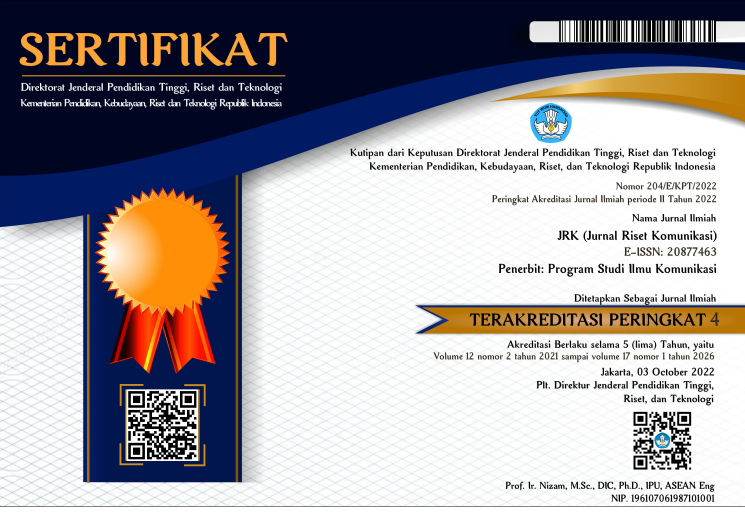PARTISIPASI ELEMEN MASYARAKAT FILM TERHADAP PERSOALAN LINGKUNGAN HIDUP
Abstract
Full Text:
PDFReferences
Barry, S. (2016). Fenomena Komunitas Film. Jurnal Kalatanda, 1(Vol 1, No. 2), 125–160.
Bieniek-Tobasco, A., McCormick, S., Rimal, R. N., Harrington, C. B., Shafer, M., & Shaikh, H. (2019). Communicating climate change through documentary film: imagery, emotion, and efficacy. Climatic Change, 1–18. https://doi.org/10.1007/s10584-019-02408-7
Corbett, J. B. (2006). Communicating Nature : How We Create and Understand Environmental Messages (Vol. 12). Island Press.
Downing, J. (2001). Radical Media: Rebellious Communication and Social Movement. Sage Publication.
Eastwood, A., Juárez-Bourke, A., Herrett, S., & Hague, A. (2021). Connecting young people with greenspaces: The case for participatory video. People and Nature. https://doi.org/10.1002/pan3.10236
Flor, A. G. (2004). Environmental Communication: Principles, Approaches, Strategies of Communication Appleid to Environmental Management. University of the Philippines, Open University.
Greitemeyer, T. (2013). Beware of climate change skeptic films. Journal of Environmental Psychology, 35, 105–109. https://doi.org/10.1016/j.jenvp.2013.06.002
Hansen, A. (2015). Promising directions for environmental communication research. Environmental Communication, Environmental Communication, 9(3), 384–391.
Hemer, O. T. T. (2016). Voice & Matter: Communication, Develop- ment and the Cultural Return. Nordicom, University of Gothenburg.
Hughes, H. (2014). Green documentary environmental documentary in the twenty-first century. In Green Documentary Environmental Documentary in the Twenty-First Century.
Jurin, R. R., Roush, Donny., & Danter, J. (2010). Environmental Communication, Skills and Principles for Natural Resource Managers, Scientists, and Engineers. In Springer (2nd ed.).
Kheerajit, C., & Flor, A. G. (2013). Participatory development communication for natural resources management in Ratchaburi Province, Thailand. Procedia – Social and Behavioral Sciences, 103, 703–709.
Kranich, N. (2000). A question of balance: the role of libraries in providing alternatives to the mainstream media. Collection Building, 19(3), 85–91. https://doi.org/10.1108/01604950010337623
Littlejohn, S. W., Foss, K. A., & Oetzel, J. G. (2017). Theories of Human Communication (11th ed.). Waveland Press.
Meisner, M. (2015). Environmental Communication: What It Is and Why It Matters. https://www.theieca.org/resources/environmental-communication-what-it-and-why-it-matters#:~:text=In%20environmental%20affairs%2C%20communication%20guides,importantly%2C%20the%20natural%20world%20itself.
Milstein, T. (2011). Nature identification: The power of pointing and naming. Environmental Communication, 5(1), 3–24. https://doi.org/10.1080/17524032.2010.535836
Namsai Engchuan, R. (2020). A Political Dance in the Rain. 176(1), 7–36. https://doi.org/10.2307/26910982
Pezzullo, Phaedra C; Cox, R. (2018). Environmental Communication and the Public Sphere (5th ed.). SAGE Publication.
Pusparisa, Y. (2021, March 30). Mayoritas Komunitas Film Indonesia Ada di Jawa, Persebaran Komunitas Film Indonesia (2018). Katadata.Co.Id.
Servaes, J. (1999). Communication for Development: One World, Multiple Cultures. Hampton Press.
UU Republik Indonesia tentang Perfilman, Pub. L. No. 33 (2009).
DOI: http://dx.doi.org/10.31506/jrk.v13i2.17478
Refbacks
- There are currently no refbacks.









